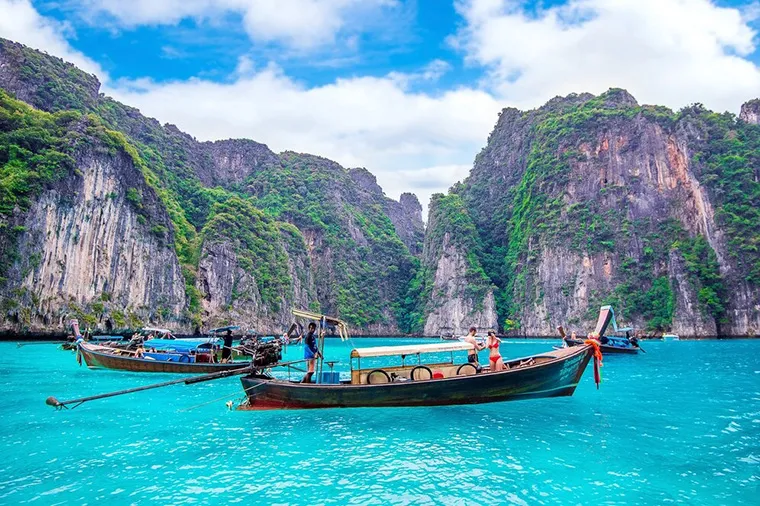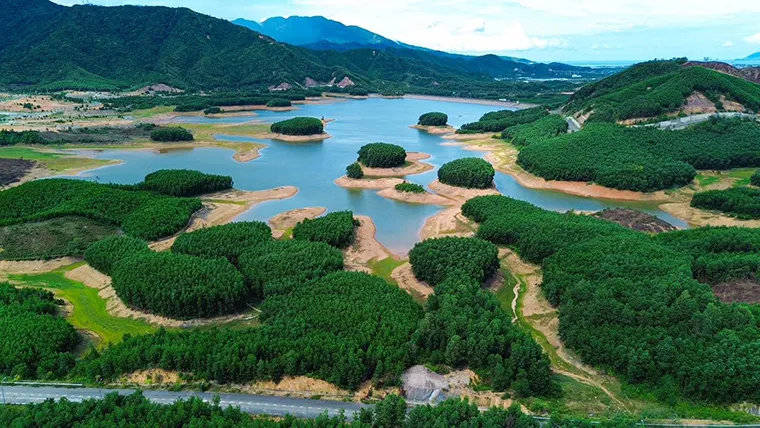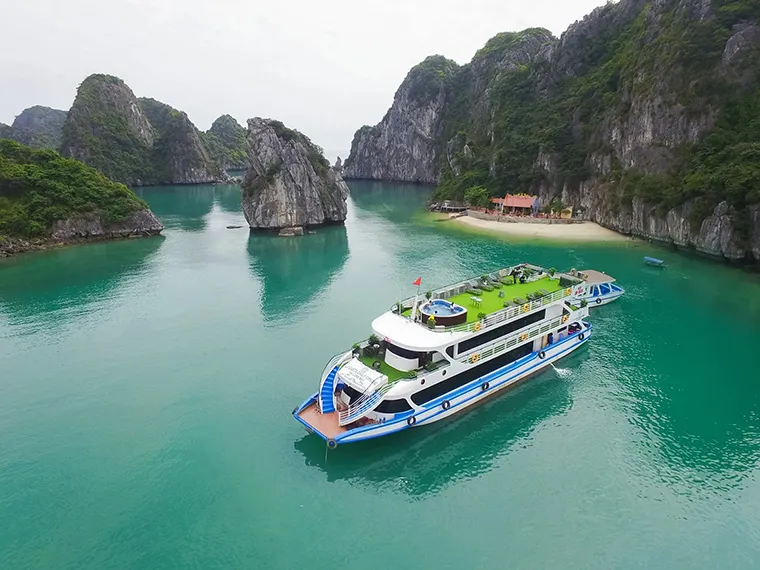How Did Ha Long Bay Form? Unveiling The UNESCO-recognized Wonder!
Nestled in the northeastern sea of Vietnam, Ha Long Bay emerges as a masterpiece of nature, with thousands of majestic limestone islands rising from the emerald waters. How was Ha Long Bay created and why was it recognized by UNESCO as a World Heritage Site? Join Joytime Travel Agency as we uncover the mystery of Ha Long Bay's formation in the article below!
1. How Did Ha Long Day Form?
Summary of Ha Long Bay's Formation Process
|
Stage |
Key Process |
Result |
|
500+ million years ago |
Marine sediments formed thick limestone layers. |
Foundation for karst landscape. |
|
Tectonic Movements |
Plates shifted, creating fractures & cliffs. |
Thousands of rocky islands. |
|
Erosion & Weathering |
Rainwater dissolved limestone → caves & stalactites. |
Famous caves & unique formations. |
|
Sea Level Changes |
Rising: valleys submerged → small bays & lakes. Falling: hidden caves revealed. |
Constantly changing landscape. |
|
Final Result |
Millions of years of transformation. |
Ha Long Bay - A natural wonder. |
Geological Formation Process: Ha Long Bay underwent a geological formation process lasting over 500 million years. Initially, this area was deep beneath the ocean, where layers of marine organisms gradually accumulated and formed massive limestone strata. Particularly, between 340 and 240 million years ago (Carboniferous and Permian periods), the bay region began to develop a limestone layer thicker than 1,000 meters, laying the foundation for the thousands of rocky islands we see today.
If you're curious about the meaning behind its name, you can find out what does ha long bay mean.
The movement and collision of tectonic plates caused the limestone to fracture, inadvertently creating deep fissures or vertical cliffs. Additionally, the tropical humid climate and slow tectonic uplift helped the bay develop a unique karst topography – a fully developed karst landscape rarely found in the world.

Ha Long Bay has been recognized by UNESCO as a World Natural Heritage Site. - Photo source: Freepik
Erosion and Weathering Process:
Over millions of years, rainwater gradually seeped through cracks, dissolving with limestone, creating countless stunning caves. The stalactites and stalagmites here possess unique shapes, like a magnificent work of art. Some islands stand out with strange shapes, such as Trong Mai Islet (Kissing Rocks) and Dau Nguoi Island (Human Head Island), which are vivid imprints of the long and continuous weathering process of time.
Impact of Sea Level on Island Structure Transformation: Sea level also plays a significant role in the miraculous transformation of Ha Long Bay. As sea levels rise, limestone valleys submerge, turning into hundreds of small bays or crystal-clear lakes. Conversely, when the water recedes, caves that were once hidden beneath the seabed gradually emerge with more intricate beauty. This process repeats countless times throughout glacial cycles.
In the Quaternary period, especially the Pleistocene epoch (approximately 2 million to 11,000 years ago), sea levels fluctuated ceaselessly, constantly reshaping the landscape. The rhythmic transformation of nature has painted a vivid picture, where each rocky island and each cliff face carries astonishing beauty.
And if you're wondering about its location, explore at where is ha long bay in vietnam.

Poetic and picturesque scenery of the bay from a high vantage point. - Photo source: Facebook Halong Bay Vietnam - Ha Long Bay Tourism
2. Exploring The Magnificent Beauty of Ha Long Bay from Multiple Angles
The bay area harbors countless natural wonders that endlessly captivate and intrigue travelers.
2.1. The grandeur and uniqueness of the Karst topography
Ha Long Bay is one of the most unique marine karst systems in the world. The complete karst evolution process has taken place over approximately 20 million years, thanks to a combination of thick limestone layers, a hot and humid climate, and a slow tectonic uplift process. The combination of environment, climate, geology, and geomorphology has created a diverse and rich biological population.
The beauty of Ha Long Bay is created from three elements: rock, water, and sky, like a lyrical ink-wash painting.
-
Limestone Islands and Mountains: The bay area boasts over 1,969 islands of various sizes, some dating back 300 years. The limestone here is so pure that when sunlight shines upon it, the rock's surface glows as if covered with sparkling silver. Each island possesses a unique shape, such as Trong Mai Islet (Kissing Rocks), a symbol of enduring love, and Cho Da Islet (Stone Dog), standing tall like a sentinel guarding the bay.
-
Majestic Caves: Ha Long Bay is a "paradise" of magnificent limestone caves, formed over millions of years by the erosion of seawater. Stalactites and stalagmites inside the caves create fantastical shapes, shimmering when light shines upon them. Sung Sot Cave (Surprise Cave) is vast with layers of brilliant stalactites, like a natural palace; Dau Go Cave (Wooden Head Cave) carries a mystical beauty tied to history; and Thien Cung Cave (Heavenly Palace) resembles a vivid stone painting with countless wondrous shapes.
-
Lakes within the Rocky Mountains: Hidden among the majestic limestone mountain ranges, the lakes in Ha Long Bay are like mysterious green gems. These lakes are often surrounded by vertical cliffs, with crystal-clear water, and are home to many unique species. Ba Ham Lake is famous for its rich ecosystem and poetic scenery, creating a tranquil and enchanting space for those who want to explore the pristine beauty of nature.

Rich Ecosystem in Ha Long Bay. - Photo Source: Facebook Vietnamnet.vn
2.2. Diverse and rich ecosystems from hills, caves, mangroves, to coral reefs
If you're planning to explore these diverse ecosystems, you might be wondering how to go to ha long bay. Once you arrive, you'll find that Ha Long Bay preserves a typical ecosystem of the tropical sea region with the following 8 distinctive ecosystems:
- Vegetation: Over 500 plant species thrive here, including 21 rare and endangered species like the slipper orchid, and 17 endemic species found nowhere else globally.
- Tung Ang Ecosystem: These isolated karst water pools, "Ang," and larger coves, "Tung," are encircled by limestone islands. This unique environment has fostered the evolution of endemic species, including 21 types of algae, 37 mollusk species, and precious corals, showcasing incredible adaptation to a closed system.
- Cave Ecosystem: The bay's numerous caves, formed over millennia, host specialized biological communities adapted to low light and stable temperatures. Though not species-rich, they harbor rare and endemic organisms like the cave gecko and Ha Long cave crab, invaluable for scientific research.
- Hard-Bottom Intertidal Ecosystem: Found at the base of the islands, this rocky habitat supports about 423 species, including seaweed, corals, and various crustaceans, many of which are a staple for local fishermen.
- Soft-Bottom Intertidal Ecosystem: This crucial habitat nurtures mollusks, crustaceans, and small fish, offering a glimpse into the bay's intricate biodiversity.
- Mangrove Ecosystem: Acting as a vital green barrier, mangroves protect the coastline from erosion and serve as a breeding ground for diverse flora and fauna. These pristine forests offer a serene ecotourism experience, allowing visitors to paddle through lush canopies and connect with nature.
- Coral Reef Ecosystem: Beneath the clear waters, hard coral reefs create breathtaking underwater landscapes. Exploring these vibrant reefs through diving is a must-do, revealing a spectacular aquatic world teeming with colorful fish and shimmering corals.
- Seagrass Meadow Ecosystem: These meadows are essential for maintaining water quality and preventing seabed erosion, contributing significantly to the bay's pristine marine environment. They offer nature enthusiasts an exciting opportunity to understand the delicate balance of Ha Long Bay's ocean.
These diverse ecosystems, deeply intertwined with the fascinating geological processes that answer how was Ha Long Bay formed, make the bay a truly remarkable natural heritage site.

Enjoying Ha Long Bay on a luxury cruise with Joytime. - Photo Source: Joytime Travel Agency
Only by witnessing Ha Long Bay with their own eyes can visitors fully appreciate its majestic and poetic beauty. Joytime Travel Agency is always ready to accompany travelers on their journey to discover this World Heritage Site, providing valuable travel experiences. Each service is meticulously crafted, catering to international visitors with three core values: professionalism, dedication, and reasonable pricing.
|
Package |
Details |
Price |
|
Enjoy the beauty of Ha Long Bay on a cruise ship. Experience activities such as kayaking, squid fishing, and sunset parties. Visit Sung Sot Cave, Titop Island, Luon Cave, and a pearl farm. Enjoy a BBQ dinner. Free herbal bath. |
105,6 USD |
|
|
Wooden cruise combining traditional and luxurious styles. Luxurious, private, and comfortable bedrooms. Enjoy a lunch with over 20 dishes. Admire the panoramic view of the bay's majestic mountains. Experience a local bamboo boat ride. |
38,8 USD |
|
|
An unforgettable evening on the beautiful Ambassador cruise. Immerse yourself in exquisite cuisine, music, and brilliant lights. Music performances by talented international bands and top Vietnamese singers. Numerous culinary masterpieces of European and Asian cuisine. |
39.8 USD |
3. FAQs about How Was Ha Long Bay Created
Ever wondered about Ha Long Bay's stunning islands? If you're curious how did Ha Long Bay form, these FAQs answer your questions about its incredible creation!
3.1. What caused the island in Ha Long Bay?
The islands of Ha Long Bay were formed primarily by limestone erosion over millions of years.
These towering karsts are essentially the remnants of ancient limestone mountains that were uplifted by tectonic activity. Over time, constant rainwater seeping into cracks and fissures in the limestone gradually dissolved the rock, widening these openings. As sea levels rose, the lower, more eroded sections were submerged, leaving only the iconic peaks visible above the water.
3.2. Why does Halong Bay look like that?
Ha Long Bay's distinctive look of emerald waters and limestone towers is due to millions of years of geological processes, primarily limestone erosion and tectonic activity. Its unique seascape isn't volcanic, but rather a result of ancient limestone mountains being sculpted by rain and rising sea levels, leaving behind the iconic karst formations.
3.3. What is a fun fact about Ha Long Bay?
A fun fact about Ha Long Bay is its name, "Ha Long," translates to "descending dragon," inspired by a Vietnamese legend. The myth says dragons sent by gods to protect Vietnam spit out emeralds and jade, which became the bay's iconic limestone islands and islets.
3.4 Is Ha Long Bay a 7 Wonder?
In 2011, Ha Long Bay, located in Quang Ninh Province, Vietnam, was officially named one of the New 7 Wonders of Nature by the New7Wonders Foundation, following a global poll that attracted millions of votes. The final list includes:
Ha Long Bay is not just a natural masterpiece but also a living testament to millions of years of geological formation. Each island, each cave, and each stretch of blue water holds a story of the Earth's transformation and the vibrant life of nature. Explore Ha Long today to set foot in one of the most beautiful regions in the world.
Joytime Travel Agency - Vietnam's leading reputable tour provider!
|
Joytime Travel Agency - Travel JOY, TIMEless Vietnam Follow us for travel tips, local insights, and exclusive offers:
|

Danish Nguyen
Danish Nguyen is a renowned travel blogger in Vietnam with over 5 years of experience sharing unique travel experiences. With a passion for exploring new places, Danish captures incredible moments and provides readers with valuable tips to discover the beauty of his homeland.


















